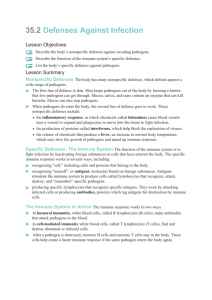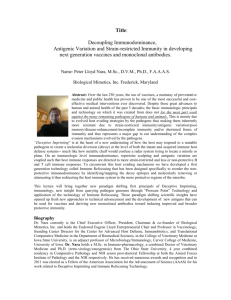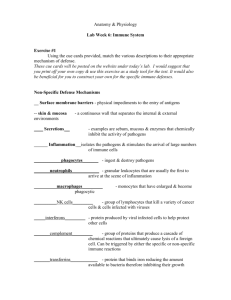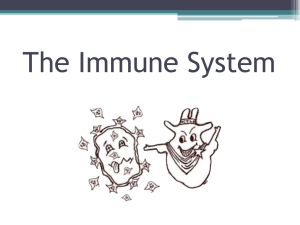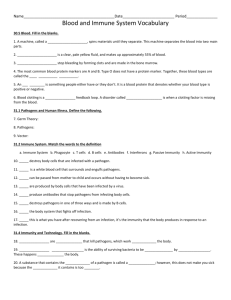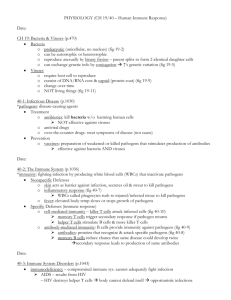35-2 Reading Guide
advertisement
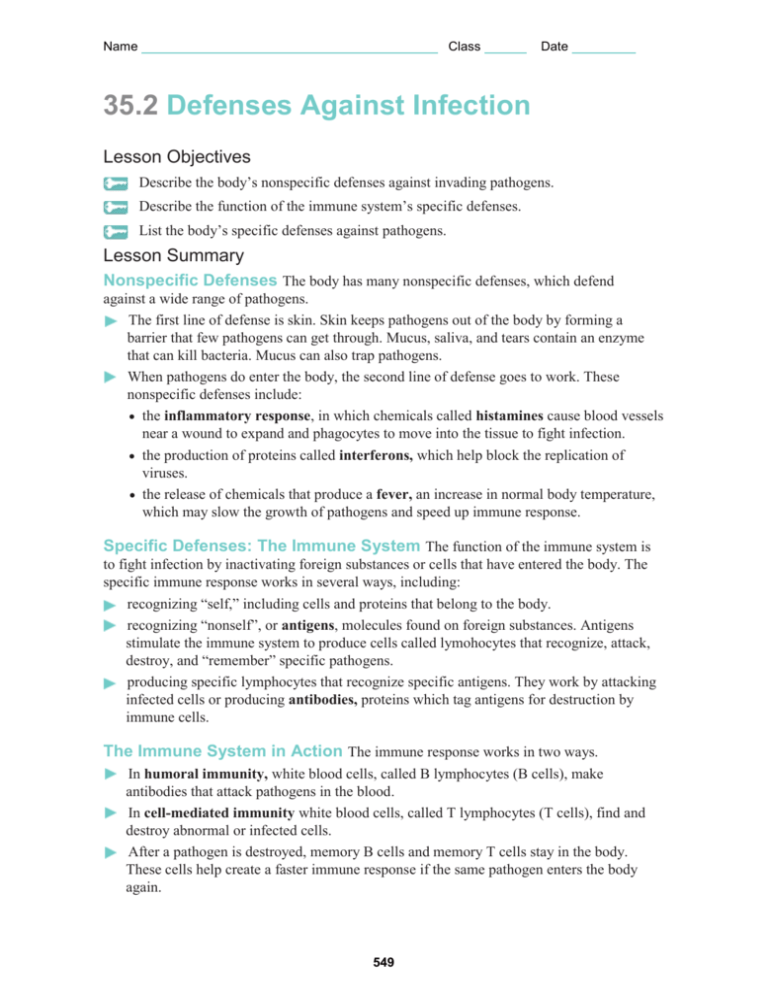
Name Class Date 35.2 Defenses Against Infection Lesson Objectives Describe the body’s nonspecific defenses against invading pathogens. Describe the function of the immune system’s specific defenses. List the body’s specific defenses against pathogens. Lesson Summary Nonspecific Defenses The body has many nonspecific defenses, which defend against a wide range of pathogens. The first line of defense is skin. Skin keeps pathogens out of the body by forming a barrier that few pathogens can get through. Mucus, saliva, and tears contain an enzyme that can kill bacteria. Mucus can also trap pathogens. When pathogens do enter the body, the second line of defense goes to work. These nonspecific defenses include: the inflammatory response, in which chemicals called histamines cause blood vessels near a wound to expand and phagocytes to move into the tissue to fight infection. the production of proteins called interferons, which help block the replication of viruses. the release of chemicals that produce a fever, an increase in normal body temperature, which may slow the growth of pathogens and speed up immune response. Specific Defenses: The Immune System The function of the immune system is to fight infection by inactivating foreign substances or cells that have entered the body. The specific immune response works in several ways, including: recognizing “self,” including cells and proteins that belong to the body. recognizing “nonself”, or antigens, molecules found on foreign substances. Antigens stimulate the immune system to produce cells called lymohocytes that recognize, attack, destroy, and “remember” specific pathogens. producing specific lymphocytes that recognize specific antigens. They work by attacking infected cells or producing antibodies, proteins which tag antigens for destruction by immune cells. The Immune System in Action The immune response works in two ways. In humoral immunity, white blood cells, called B lymphocytes (B cells), make antibodies that attack pathogens in the blood. In cell-mediated immunity white blood cells, called T lymphocytes (T cells), find and destroy abnormal or infected cells. After a pathogen is destroyed, memory B cells and memory T cells stay in the body. These cells help create a faster immune response if the same pathogen enters the body again. 549 Name Class Date 35-2 Defense against Infection – Reading Guide Nonspecific Defenses For Questions 1–8, write the letter of the definition that best matches each term. Term Definition A. An increase in body temperature, which slows or stops pathogens 1. skin 2. lysozyme B. A secretion of the nose and throat that traps pathogens 3. inflammatory response C. An enzyme found in tears and saliva that breaks down bacterial cell walls 4. histamines D. Chemicals that increase blood flow to tissues 5. interferons 6. fever E. Combination of physical and chemical barriers that defend against pathogens 7. mucus F. Redness, pain, and swelling at the site of an injury 8. nonspecific defenses G. Proteins that fight viral growth H. The body’s most important nonspecific defense Specific Defenses: The Immune System For Questions 9–14, complete each statement by writing the correct word or words. 9. The response is the body’s response to specific invaders. 10. A substance that triggers the immune response is known as a (n) 11. The main role of immune-system cells. is to tag 12. The main working cells of the immune system are two types of specific types are determined by a person’s . . for destruction by . Their 13. discover antigens in body fluids. 14. defend the body against pathogens that have infected body cells. 15. THINK VISUALLY In the space provided, draw an example of each type of lymphocyte indicated to show a basic difference between the two types of cells. B Cell T Cell 550 Name Class Date The Immune System in Action For Questions 16–22, write True or False on the line provided. 16. Humoral immunity is a response to pathogens in blood and lymph. 17. The first response of humoral immunity to infection is much faster than the second response. 18. Plasma cells are specialized B cells. 19. Cell-mediated immunity involves antibodies. 20. Cell-mediated immunity causes infected body cells to die. 21. Cell-mediated immunity only works on viral diseases. 22. Cytotoxic T cells are a cause of rejection of transplanted organs. 23. Complete the table to compare how humoral and cell-mediated immunity work after a virus invades the body for the first and second times. Humoral Immunity vs. Cell-Mediated Immunity Action of Humoral Immunity Primary response: Action of Cell-Mediated Immunity Primary response: Macrophages consume viruses and display their antigens on the cell surface. Helper T cells are activated. Activated B cells grow and divide rapidly. Helper T cells activate B cells and cytotoxic T cells and produce memory cells. Plasma cells release antibodies that capture antigens and mark them for destruction. Secondary response: Secondary response: Apply the Big idea 24. A runny nose is a symptom of a cold. How is this evidence that the body’s immune defenses are working? 551
